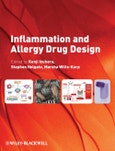Inflammation and Allergy Drug Design explains the biologic science that underpins the pathophysiology of asthma and related disorders, as well as their mechanisms. This authoritative guide consists of 25 chapters, each detailing the cutting-edge developments in a particular field. It is divided into three parts, covering cytokines, chemokines, grow factors and mediators.
This book allows immunologists, allergologists and researchers in the pharmaceutical industry to learn and appreciate the target biology in drug development. It also provides medical and pharmaceutical postgraduate
students and clinicians with a basic understanding of allergic diseases in the respiratory tract.
Table of Contents
Contributors, viiPreface, xiii
Part I: Cells contributing to the pathogenesis of allergic diseases in the respiratory tract
1 Novel anti-infl ammatory drugs based on targeting lung dendritic cells and airway epithelial cells, 3
Bart N. Lambrecht, Maud Plantinga, Monique Willart, and Hamida Hammad
2 Role of Th2 cells in the allergic diathesis, 15
Marsha Wills-Karp
3 Importance of Th17- and Th1-associated responses for the development of asthma, 27
Tomohiro Yoshimoto, Hiroko Tsutsui, and Kenji Nakanishi
4 Regulatory T cells, 39
Chris Corrigan and Kimuli Ryanna
5 A role for natural killer T-cell subsets in the pathogenesis of various allergic disorders, 59
Hiroshi Watarai, Michishige Harada, Mayumi Tamari, and Masaru Taniguchi
6 Regulatory roles of B cells in allergy and infl ammation, 67
Kiyoshi Takatsu, Masashi Ikutani and Yoshinori Nagai
7 Mast cells, 79
Mindy Tsai and Stephen J. Galli
8 Eosinophils, 107
Nancy A. Lee, Mark V. Dahl, Elizabeth A. Jacobsen, and Sergei I. Ochkur
9 Basophils in infl ammation and allergy drug design, 123
Donald MacGlashan, Jr.
10 Epithelial cells, 139
Tillie-Louise Hackett, Stephanie Warner, Dorota Stefanowicz, and Darryl Knight
11 Fibroblasts, 149
Alastair G. Stewart, Lilian Soon, and Michael Schuliga
12 Airway smooth muscle cells, 163
Andrew J. Halayko and Pawan Sharma
Part II: Cytokines contributing to the pathogenesis of allergic diseases in the respiratory tract
13 Interleukin 4, interleukin 13, and interleukin 9, 175
Kenji Izuhara, Shoichiro Ohta, Hiroshi Shiraishi, and Shoichi Suzuki
14 Interleukin 3, interleukin 5, and granulocyte–macrophage colony-stimulating factor, 187
Alba Llop-Guevara, Josip Marcinko, Ramzi Fattouh, and Manel Jordana
15 Interleukin 15, interleukin 17, and interleukin 25, 197
Hiroshi Nakajima and Itsuo Iwamoto
16 Thymic stromal lymphopoietin, 205
Kazuhiko Arima and Yong-Jun Liu
17 Interleukin 10, 215
Whitney W. Stevens, Larry Borish, and John W. Steinke
18 Tumor necrosis factor alpha, 225
Christopher Brightling, Latifa Chachi, Dhan Desai, and Yassine Amrani
19 Profi brotic and angiogenic factors in asthma, 237
Neville Berkman and Francesca Levi-Schaffer
20 Chemokines, 253
Luis M. Teran and Juan R. Velazquez
21 Epithelial growth factors, 263
Yasuhiro Gon and Shu Hashimoto
Part III: Other mediators contributing to the pathogenesis of allergic diseases in the respiratory tract
22 Prostanoids, 273
Sarah A. Maher, Deborah L. Clarke, and Maria G. Belvisi
23 Leukotrienes, 285
Katsuhide Okunishi and Marc Peters-Golden
24 Proteases in allergy, 297
Keisuke Oboki and Hirohisa Saito
25 Toll-like receptors, 307
Jessica L. Allen, Aurelien Trompette, and Christopher L. Karp
Index, 317
Samples

LOADING...








